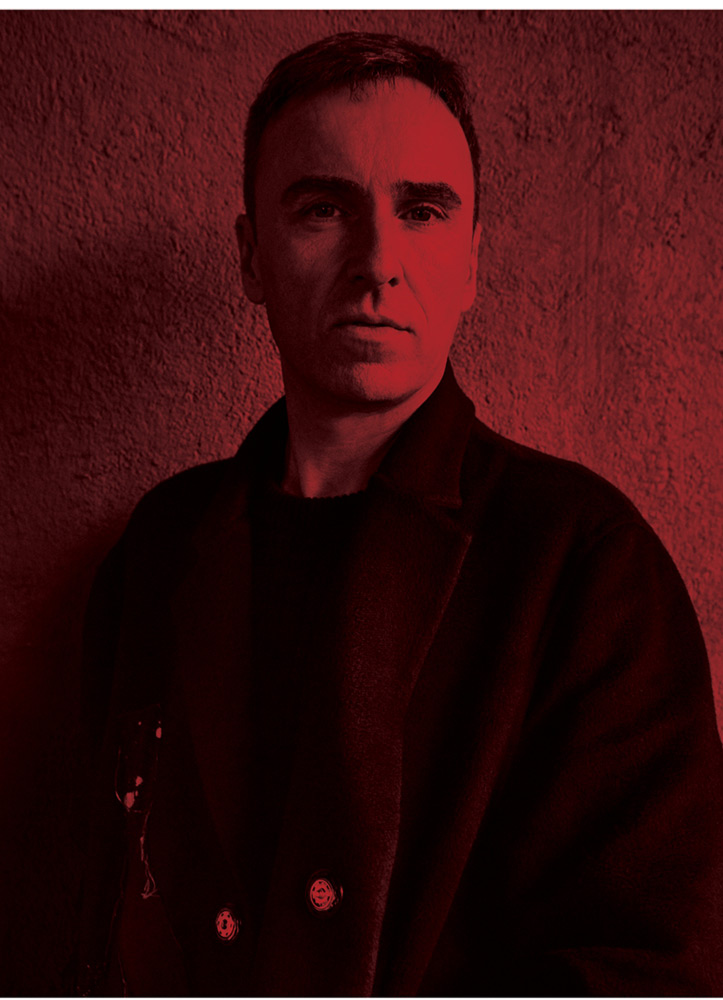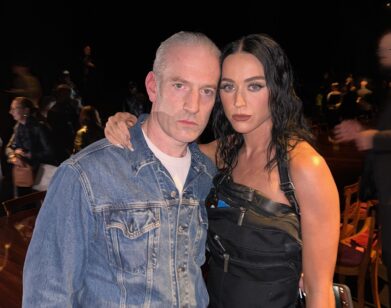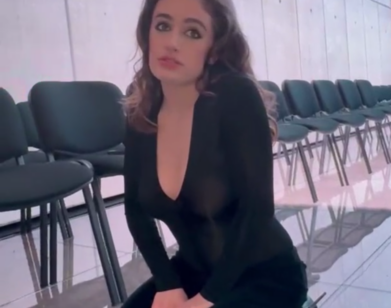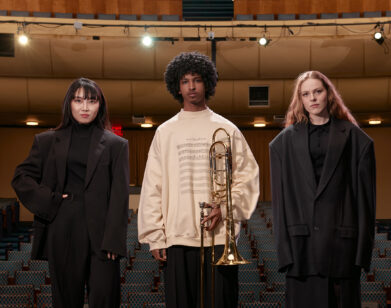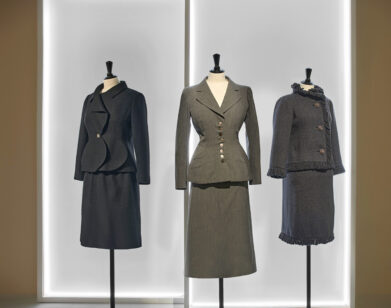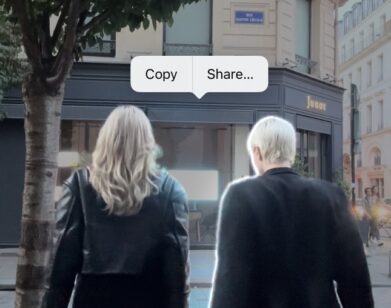The uncanny parallels between Demna Gvasalia and Raf Simons
Although the two live and show in separate cities—Raf Simons is based in New York and Demna Gvasalia in Zurich—their work is an impossible conversation of commonalities, both in starting point and outcome. Since taking over as the chief creative officer at Calvin Klein, Simons, originally from Belgium, moved his life to Manhattan, where he also runs his namesake line. Gvasalia, originally from Georgia, operates Vetements, the cultish design collective he founded and remains the public face of, out of Switzerland, where he also moved the Balenciaga headquarters after taking over as artistic director in 2015. The two have never met, but together they are the epitome of postmodernist designers, taking inspiration from various unlikely sources and orchestrating them into cohesive and layered collections. Together, they both display a mastery of youth culture and style tribes in the age of the Internet and form a line of communication between the street and the rarified air of the most exclusive ateliers.
The aesthetic and ideological connection between Simons and Gvasalia can be traced back to their relationships with Martin Margiela. To appreciate their work is to understand the philosophies of form and design pioneered by the elusive Belgian designer. Simons, who studied industrial and furniture design, fully grasped fashion’s artistic potential after attending a Margiela show in Paris in 1991. Gvasalia’s route was more direct: he graduated from the Royal Academy of Fine Arts in Antwerp, honing his craft in the same classrooms and studios as Margiela himself. Gvasalia went on to lead the design team for the house of Margiela from 2009 to 2012, and credits his tenure there with being integral to his current success. “That’s where I learned about clothes, and I think that’s where the first creative door opened,” he says. “That’s when I realized that I need to know how to make that jacket in order to make a new jacket.”
Education and birthplace aside, it’s their commitment to repurposing streetwear into high fashion that binds Simons and Gvasalia. When Simons launched the Raf Simons label in 1995, he revolutionized menswear by reexamining collegiate clothes through the lens of “youth who create their own looks,” he once said. “Like punks and new wave and new romantics.” Simons continued to explore that aesthetic with his Fall 2001 show, where he took staples of urban youth culture, such as hoodies layered under bomber jackets, and spun them into a high fashion statement that still resonates today. With Vetements, Gvasalia is responsible for the present ubiquity of the hoodie as a high fashion item. Inspired by his Soviet upbringing, he transformed traditional workwear, printed housedresses, and Levi’s 501s into desirable must-haves.
Comparisons between Margiela and Gvasalia are so common that the latter called Vetements’ Fall 2018 menswear collection “The Elephant in the Room,” a cheeky reference to Margiela’s influence on his work. Using Margiela as their jumping-off point, Simons and Gvasalia share a fascination with plays on proportion. They take archetypal items and either shrink or enlarge them to their seasonal whims. In Simons’s early work, military parkas and bombers were so big that models’ hands disappeared inside their elongated sleeves. Vetements became a sensation because their hoodies were so big that they doubled as dresses. Conversely, Simons introduced collegiate sweaters so shrunken that the hems finished above both the elbows and navel. Reacting to the popularity of his own oversize pieces, Gvasalia switched gears, showing blazers, trenches, and hoodies with shoulders so small that the model’s actual shoulder blades poked through mid-sleeve.
Simons and Gvasalia have yet another common preoccupation: making everyday objects wearable. For the Fall 2017 Balenciaga show, Gvasalia turned car mats into wrap pencil skirts that clung to the wearer’s curves. In that same collection, teacup saucers became cuffs, and key chains—adorned with used keys and charms—were bracelets. For his sophomore Calvin Klein collection, Simons used a cheerleader’s pom-poms as the basis for a mosaic of multicolored evening dresses, layered with fringe. The Raf Simons Spring 2018 menswear collection featured models holding umbrellas with glow-in-the-dark handles, transforming a mundane object into an editorial accessory.
A shared fascination with the alchemy of the known into the unknown occurs with their fashion collaborations. Gvasalia caused a sensation when he debuted candy-colored Crocs with sky-high wedges at Balenciaga’s Spring 2018 show. The uproar was reminiscent of the Vetements Spring 2017 collection, which featured collaborations with megabrands such as Levi’s, Juicy Couture, and Dr. Martens. Vetements’ most unlikely and well-known collaboration is with the German logistics company DHL. In the opening look of the Spring 2016 show, the designer and photographer Gosha Rubchinsky emerged in a bright yellow DHL logo T-shirt, which has since spawned countless copies and just as many memes. The popularity of the pieces created new visual associations for the brand and, ironically, a generation who never knew of DHL are now craving to own a piece of it. “When I see a DHL truck, I think of my brand,” Gvasalia says. “It’s so strange and bizarre—it becomes inverse appropriation, almost.”
Simons is also no stranger to collaborations. In fact, he is partly responsible for the resurgence of the Adidas Stan Smith sneaker. The iconic tennis shoe has been reinterpreted in pastels and metallics, and distressed with patent leather buckles or with velcro straps. Simons, who has an ongoing partnership with Adidas, holds the sneaker close to his heart, “I have had periods where I only wore Stan Smiths, maybe from age 15 until I was 25,” he told The Wall Street Journal in 2016.
A devoted art collector, Simons’s most encompassing collaborations have been with fine artists. For the Raf Simons Fall 2014 menswear show, he teamed up with his close friend, the Los Angeles–based painter and sculptor Sterling Ruby, to debut a collection of oversize outerwear with graphic embroideries, paint-splattered parkas, and marled knits—all worn with skinny trousers and cartoonish rubber boots. That partnership extended into Simons’s tenure at Calvin Klein when, last year, Ruby transformed the brand’s Madison Avenue flagship into a nearly all-yellow playground, with American iconography hanging from the ceiling.
A few years after the Sterling Ruby show, Simons designed an entire collection with the Robert Mapplethorpe Foundation. He created looks inspired by the late photographer’s iconic personal style, adorning smock-style shirting, T-shirts, and puffer vests with Mapplethorpe’s prints. Even the models were cast in the Mapplethorpe mold: mopey-haired brunettes wearing leather daddy caps. Simons’s collaborations mirror those of Gvasalia’s: by recontextualizing and reappropriating the known, be they objects or bodies of art, the meaning of both the original and the product it yields are fundamentally changed and forever linked. The DHL shirt is inseparable from Vetements in the same way that Ruby’s and Mapplethorpe’s work are now linked with Raf Simons’s visual legacy.
Simons and Gvasalia overtly reference couture and bring fresh takes to its storied traditions. As the artistic director of Dior, a position he held from 2012 to 2015, Simons used couture fabrics such as organza and duchess satin to create sporty anoraks and parkas, and did the same for Raf Simons menswear, using the heavy satin to create backpacks and matching T-shirts. At Calvin Klein, he remade utilitarian military shirts into satin and transformed sport fabrics such as nylon into couture-inspired gowns.
At Balenciaga, Gvasalia confronts the modernity of couture head-on by “trying to translate it into 21st century,” he says. “The idea of beauty, elegance, comfort, and style back then—how would it be now?” His answer: taking essentials of the modern wardrobe such as the trench, the peacoat, even the denim jacket and injecting them with the attitude of couture. Whether it be worn elegantly off-the-shoulder, constructed so the back is rounded in the iconic Balenciaga cocoon shape, or buttoned asymmetrically to give the illusion of a cape, Gvasalia’s clothes pay homage to the history of the house without looking back.
A keen understanding of youth culture and the potential of the internet help to further distinguish Simons and Gvasalia from their peers. At Vetements, Gvasalia has become an icon to hypebeasts and fashion editors alike. His clothes and their distribution model of channeling different products into different vendors with separate drop dates reflects the release strategies for collectible sneakers and results in waiting lists and physical queues for products. That same strategy has carried over to his work at Balenciaga, where covetable pieces like the brand’s oversize bazaar tote bags and triple-soled sneakers have been anticipated with a fervor that inspires countless knock-offs.
Simons is a frequent reference point for many contemporary streetwear designers. He is name-dropped in rap songs and deified on sneakerhead Instagram feeds. Remixing the style tribes of youth—punk, prep, loner—has been integral to his design ethos since founding his brand. His clothes were always cut for sons, not fathers. For years he did shows without seating, where the models would walk through the crowd of voyeurs as they would an underground punk show. Before that, there were presentations with mazes of escalators and stairs. One in particular, at the Gagosian in Paris, featured models walking through a Prouvé-designed gas station underneath a Calder mobile. These were Instagrammable moments before that was every PR director’s biggest concern.
Simons and Gvasalia put as much thought into the construction of garments as they do into the packaging, presentation and distribution of them. These are all thoroughly modern concerns of a designer, but they’ve each done it in ways that have challenged the common notions of success and influenced their contemporaries.
Designers emulating each other is a staple of the fashion system at large—entire Instagram accounts are now devoted to playing reference police. Marc Jacobs openly admits his admiration for designers such as Rei Kawakubo and Miuccia Prada. Prada herself is a known fan of Yves Saint Laurent, the designer who, like Margiela for Simons, showed her the artistic merits of a career in fashion design. What is so special about the bond between Simons, Gvasalia, and Margiela is that their work as a whole is a testament to the principles established by their predecessor. Despite the visual similarities, it is a philosophical agreement that bonds them. They continue to embody the principles that Margiela stood for. Even as they veer far away from his aesthetic language, the spirit of Margiela is felt in all that they do.
These principles of reappropriation, recontextualization, and reinterpretation are the crux of the design ethos that Simons and Gvasalia share. The spirit of collaboration, modernizing couture construction, and dissecting the known to create something unknown are all qualities that link them and have made them into the preeminent designers of today. It is as much a testament to their vision and talent as it is a sign of our times: a great designer creates and capitalizes on that.

